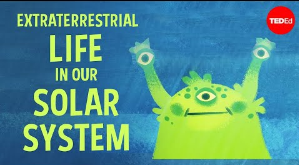Deep in our solar system, a new era of space exploration is unfolding.
在太阳系的深处,太空探索的新时代正在发生。
Beneath the thick ice of Europa, in the vapor plumes on Enceladus,
在木卫二的厚厚冰层之下、在土卫二的蒸汽羽流中,
and within the methane lakes of Titan, astrobiologists are on the hunt for extraterrestrial life.
以及在土卫六的甲烷湖里,天体生物学家正在寻找外星生命的线索。
We've honed in on these three moons because each is an 'ocean world,' an environment that contains a liquid ocean
之所以他们锁定在以上的三个卫星,是因为它们每个都是“海洋星球”,即拥有液态的海洋环境,
and liquid can support the formation of life.
而液体是形成生命的基础条件。
Living organisms have to be able to grow, reproduce, and feed themselves, among other things.
除其它因素外,有机生物体必须要有能生长、繁殖和食物养活的环境。
All of those functions require the formation of complex molecules from more basic components.
所有这些功能都源于复杂的分子,由更基本的成分组成。
Liquids such as water allow chemical compounds to remain in suspension instead of sinking under the force of gravity.
水样液体能够使化合物保持悬浮,而非因重力的作用而下沉。
This enables them to interact frequently in a 3-dimensional space and,
使得它们能够在三维空间中,作出频繁的相互作用,
in the right conditions, go through chemical reactions that lead to the formation of living matter.
并在合适的条件下,产生化学反应,从而产生生命的物质。
That alone isn't enough; the small but complex biomolecules that we're familiar with are sensitive to temperature
仅仅是这点,并不足够,我们熟悉的复杂而微小的生物分子对温度很敏感,
too hot or cold, and they won't mix.
太热或太冷,它们都不会结合。
Liquid water has an additional advantage in that it's relatively temperature-stable,
液态水还有另外的优点,就是温度相对稳定,
meaning it can insulate molecules against large shifts in heat.
意味着液态水能够将分子从巨大温差中隔离。
On Earth, these and other conditions in aquatic environments may have supported the emergence of life billions of years ago.
地球上,某些水生环境的特性,可能催生了数十亿年前生命的出现。
Tantalizingly, the same could be true in other parts of our solar system, like these three icy moons.
这个发现,令人急于求证太阳系其他部分,也有生命的可能,譬如这三个冰冷的卫星。
Europa, which is a moon of Jupiter, is probably the most intriguing ocean world.
木卫二是木星的一个卫星,它或许是最令人感兴趣的海洋星球。
Beneath a surface layer of ice thicker than Mount Everest, there exists a liquid ocean as much as 100 kilometers deep.
在比珠穆朗玛峰的高度还厚的冰层底下,是个深达100公里的液态海洋。
Astrobiologists think this hidden ocean could harbor life.
这让天体生物学家相信,这个隐藏着的海洋可能孕育着生命。
Thanks to the Galileo probe, we can deduce that its potential salt content is similar to that of some lakes on Earth.
这就多亏了伽利略探测器,我们推断液态海洋可能的含盐量与地球上的某些湖泊相近。
But most of its characteristics will be a mystery until we can explore it further.
大部分现象还需更多的探索,才能解开谜团。
Like Jupiter, Saturn also has moons that might have the right conditions for life.
就像木星一样,土星的卫星也可能拥有适合生命的条件。
For instance -- Enceladus is a tiny ball of ice that's small enough to nestle within the surface area of the Gulf of Mexico.
例如土卫二是一个小小的冰球,小得可以放进去墨西哥湾。

Similarly to Europa, it likely contains an ocean deep under the ice.
与木卫二相似,它也可能在厚冰层之下有个海洋。
But Enceladus also has geysers that frequently vent water vapor and tiny ice grains into space.
但土卫二还有个间歇泉,经常向太空喷射水汽和微小冰粒。
Astrobiologists are curious about whether these geysers are connected to the ocean below.
天体生物学家好奇,究竟喷泉是否与下方的海洋相连。
They hope to send a probe to test whether the geysers' plumes of vapor contain life-enabling material from that hidden sea.
他们希望发射一个探测器,以测试间歇泉的蒸汽羽流,是否在隐藏海洋中含有促成生命的物质。
Although it's the best known substance for nurturing life, water isn't necessarily the only medium that can support living things.
水虽然是孕育生命最著名的物质,但水不一定是维持生物的唯一介质。
Take Titan, Saturn's largest moon, which has a thick nitrogen atmosphere containing methane and many other organic molecules.
以土星最大的卫星土卫六为例,它有厚厚的氮气层,含有甲烷和许多其它有机分子。
Its clouds condense and rain onto Titan's surface, sustaining lakes and seas full of liquid methane.
它的云层凝结做成降雨,落到土卫六的表面上,形成充满液态甲烷的湖泊和海洋。
This compound's particular chemistry means it's not as supportive a medium as water.
液态甲烷的特殊化学性质意味着它不太像水那样能够支持生命。
But, paired with the high quantities of organic material that also rain down from the sky,
但伴随着甲烷雨,大量有机物也从天而降,
these bodies of liquid methane could possibly support unfamiliar life forms.
这些甲烷液体可能可以支持不常见的生命形成。
So what might indicate that life exists on these or other worlds?
所以什么样的条件能够显示出那些星球存在生命呢?
If it is out there, astrobiologists speculate that it would be microscopic, comparable to the bacteria we have on earth.
天体生物学家推测,如果有生物的话,也是极微小的,相当于我们地球上的细菌。
This would make it difficult to directly observe from a great distance, so astrobiologists seek clues called biosignatures.
这就很难从远处直接观察到生命了,因此,天体生物学家需要寻求称为“生物印记”的线索。
Those may be cells, fossils, or mineral traces left behind by living things.
那些可能是生物残留下来的细胞、化石或矿物痕迹。
And finding any biosignatures will be challenging for many reasons.
若要找到任何生物印记,并非容易的事情。
One of the biggest concerns is to make sure we sterilize our probes extremely thoroughly.
最大担忧之一,就是我们要确保探测器要彻底消毒。
Otherwise we could accidentally contaminate ocean worlds with Earth's own bacteria, which could destroy alien life.
否则,一不小心我们就让地球上的细菌,污染了那些海洋星球,极可能摧毁了外星的生命。
Titan, Enceladus, and Europa are just three of possibly many ocean worlds that we could explore.
土卫六、土卫二和木卫二只是众多可探索的“海洋星球”之中的三个而已。
We already know of several other candidates in our solar system,
还有在其他太阳系中已知的几个候选者,
including Jupiter's moons Callisto and Ganymede, Neptune's Triton, and even Pluto.
包括木星的卫星:木卫四和木卫三、海王星的海卫一,甚至是冥王星。
If there's this much potential for life to exist in our own tiny solar system, what unimagined secrets might the rest of the universe contain?
如果在我们小小的太阳系内都有如此多的可能性存有生物,那在宇宙的其他部分会存在着哪样我们无法想象的秘密呢?












